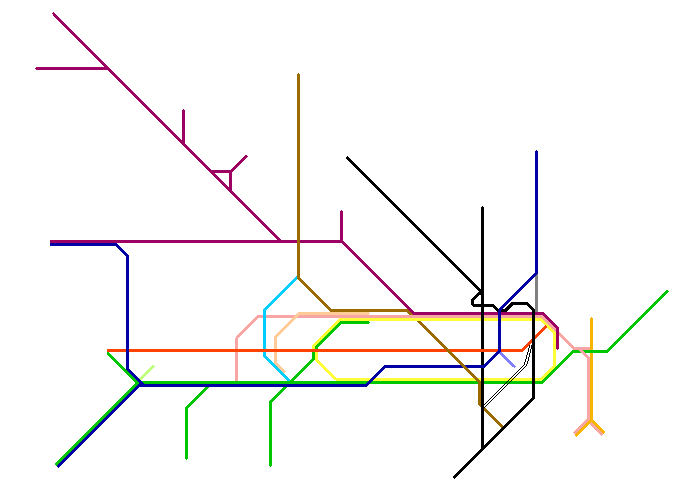 Back to Lobo.
Back to Lobo.
 Back to the Rail
index.
Back to the Rail
index.
 Back to
Clive's home page.
Back to
Clive's home page.
Lobo is based on the London Underground of the mid to late 1930s, between 1933 and 1937. A visitor from today would find the system very different, though some of the features would be familiar. This page attempts to describe the system as it was then.
Links from this page are to CULG - my detailed description of the Underground - where more information can be found.
By the end of 1913 the then London Underground consisted of two main groupings, both privately owned. The Yerkes Group operated a dense network of five tube lines plus the District. Meanwhile, the Metropolitan Railway remained independent and ran services all the way from the East End to the Buckinghamshire countryside as well as its own isolated tube in north-east London. The network was to remain largely stable for the next twenty years, though the two parts of what became the Northern Line were merged in the mid-1920s.
In 1932 and 1933 the Yerkes Group carried out a major expansion of the Piccadilly Line both eastwards (in new tubes) and westwards (sharing or taking over District Line routes), taking it from a purely central route (from Finsbury Park to Hammersmith) to the wide-ranging line we see today.
But this was to be the swansong of the private networks. On 1st July 1933 both groups, as well as various bus operators, were nationalized and brought together into London Transport.
Today's network includes seven tube lines, but the world of Lobo only had five, some very different from today. The Victoria and Jubilee Lines were yet to be built, and the Waterloo & City Line was part of the Southern Railway.
This was the same as today, except that services continued beyond Harrow & Wealdstone to Watford Junction.
In 1939 the Bakerloo gained a second branch, from Baker Street to Stanmore, only to lose it to the new Jubilee Line in 1979 (see below).
The Central Line (then the Central London Railway) was a simple east-west route, running from Liverpool Street to Ealing Broadway. The West Ruislip branch, and the whole eastern section from Liverpool Street to Woodford, Epping, and Hainault were added after World War 2 (much of the eastern section took over LNER tracks).
Though it wasn't to gain the name until 1937 (having previously been the Edgware, Highgate, and Morden Line and then the Morden-Edgware Line), the complex shape of the Northern Line - the Charing Cross and City routes through the centre, southern leg to Morden, and two northern branches - was present by 1926. The major difference to be seen was in the north: though the north-western branch had reached Edgware in 1924, the north-eastern one still led only to its original terminus at Highgate (now Archway). Trains from Moorgate and King's Cross called at Finchley Central, Mill Hill East, and High Barnet, but they ran on LNER tracks through Finsbury Park and Muswell Hill. It would not be until 1941 that the present arrangement came into use.
However, by 1936 plans were in place to extend the Northern Line as far as Bushey Heath, at the same time absorbing various LNER branches to form an even more complex arrangement than today. But war was to delay the work and, in the end, to cause much of it to be abandoned.
Like the Bakerloo, the Piccadilly in 1934 looked very much like it does today; the only changes since then are the addition of the Heathrow Airport extension and the loss of the Aldwych branch. But, unlike the Bakerloo, the 1934 situation was relatively new. In 1932 and 1933 the Piccadilly had been extended from its original core in both directions: a completely new line was built north and east from Finsbury Park to Cockfosters, while in the west it shared the District Line route from Hammersmith to Hounslow West while taking over the Acton Town to Uxbridge route from the latter.
This little-known tube line was built from Moorgate to Finsbury Park. After an unsuccessful independent start, it was taken over by the Metropolitan Railway in 1913. Some time around 1936 it was transferred to the Northern Line for operational purposes, though remaining physcally disconnected from it.
In 1976 it was transferred to British Rail, and now forms part of the WAGN network of routes.
Unlike the tube lines, which are clearly separate entities, the subsurface network has always been interconnected, and the division into separate "lines" is a matter of operational or political convenience. Today it's seen as five lines, but in the 1930s it was just two (sometimes treated as one), based around the erstwhile Metropolitan and District railways.
The main line from Baker Street to the northwest carried traffic to a mix of destinations, just as today, and Uxbridge, Watford, and Chesham remain familiar names. But the Metropolitan saw itself as a true railway rather than just an urban service, and instead of Amersham being the end of the line, trains continued to Aylesbury, Quainton Road, and then either Verney Junction (in Buckinghamshire) or Brill (near Oxford). Electric trains ran as far as Rickmansworth, with steam engines taking over trains north of there. Furthermore, as well as these five destinations, the branch to Stanmore (now part of the Jubilee Line) had opened on the 10th December 1932 and there was also a direct service from Watford to Rickmansworth.
But the 1930s were a period of retrenchment for the northern Metropolitan. The northbound service from Watford ceased at the end of 1933, the Brill branch closed at the end of November 1935, and Aylesbury to Verney Junction was to survive only until the following July.
Unlike today's single stops between Baker Street and Wembley, in the 1930s there were 9 intermediate stations resulting in large amounts of congestion as expresses from the north conflicted with local trains collecting passengers from the inner suburbs. The addition of the Stanmore branch only made this worse. So, after various other plans were abandoned, new tunnels were dug from Finchley Road to Baker Street and, in 1939, the Bakerloo Line took over the Stanmore branch and all intermediate stations - apart from the later transfer to the Jubilee, the arrangement in use today.
As well as the suburban and country routes, the Metropolitan was also an urban railway. Although not identified as a separate line, today's Circle Line had existed as the "Inner Circle" since 1884. The service now forming the Hammersmith & City Line was a familiar sight, though trains didn't venture east of Whitechapel (even in the peaks) until March 1936. And as well as the Inner Circle, the remnants of the Middle Circle still ran via Latimer Road between Edgware Road and Kensington Olympia (then called Kensington Addison Road) until 1940.
Finally, the East London Line looked much as it did today, except that as well as Shoreditch, there were trains from the Hammersmith & City service to New Cross and New Cross Gate (these were another casualty of wartime). The line was connected to main lines at all three ends and carried a huge number of goods trains in between the passengers.
The differences between the District of the 1930s and today are far fewer than those of the Metropolitan. In the east, trains had ceased to run beyond Barking in 1905, and the service had only been restored - with electrification - in September 1932.
In the middle, the District provided its share of Inner Circle services as well as operating the Edgware Road to Wimbledon service (which had been extended north from High Street Kensington in 1926). There was no shuttle service to Kensington Olympia, but the "Outer Circle", run jointly with the LMSR, carried passengers through there on their way between Earl's Court and Willesden Junction until 1940.
The biggest differences were at the west end. As well as Richmond and Ealing Broadway, trains shared the Piccadilly Line route to Hounslow West (finally withdrawing in 1964), and until October 1933 ran from Acton Town to Uxbridge as well (and for the last 16 months the District had an isolated service from South Harrow to Uxbridge, with the Piccadilly operating south of the former).
Finally, a single car shuttle operated between Acton Town and South Acton on the North London Line (part of the LMSR), with its own platform at each end; the short length of the trip meant that staff knew it as "there and back while the kettle boils".
A modern-style diagram showing all the different routes in operation (the colours partly match modern usage and are partly chosen by myself):

An actual pocket map from 1937:

Today, with the single exception of the Metropolitan Line, all Underground trains stop at every station they pass. But in the 1930s things were very different, and it was quite common for trains to miss quiet stations, or express services to run in the rush hours. For example, although trains from both Edgware and Highgate passed through Mornington Crescent, only the latter stopped.
Trains were very different to today, and all carried guards as well as drivers. "Standard stock", as illustrated on the cover of the game's box, was in use on most tube lines. This had separate motor compartments behind the driving cab as there wasn't room for all the electrical equipment beneath the floors. Despite the name, it came in a wide range of variants. The first "modern" tube train - 1938 tube stock - would come into use in a few years time.
Meanwhile the District Line was running three kinds of trains broadly similar to today's, though the earliest dated back to 1905 and even the newest to1920, and all three types look old-fashioned to modern eyes. Unlike Standard stock, the sliding doors had to be opened and closed by hand (apart from a few prototypes in 1905, pneumatic operation was not fitted until 1938).
Finally, the Metropolitan had a mix of trains similar to those on the District, some 19th century coaches converted to electric operation, compartment coaches with hinged doors that were pulled by both steam and electric locomotives, and even a couple of Pullman cars.
 Back to Lobo.
Back to Lobo.
 Back to the Rail
index.
Back to the Rail
index.
 Back to
Clive's home page.
Back to
Clive's home page.